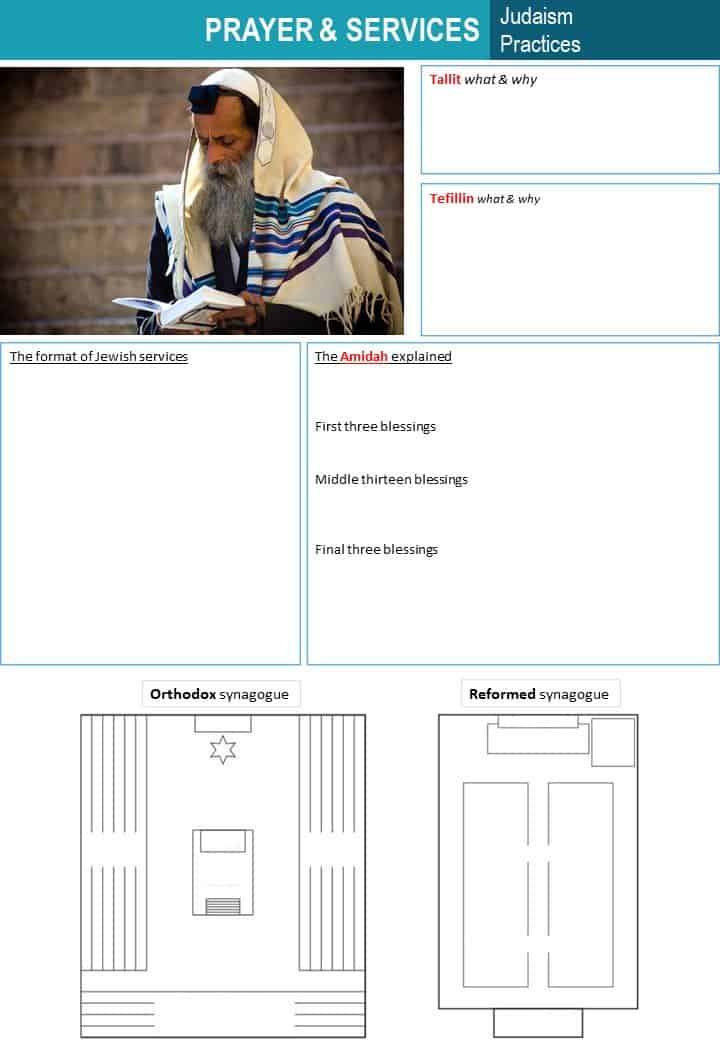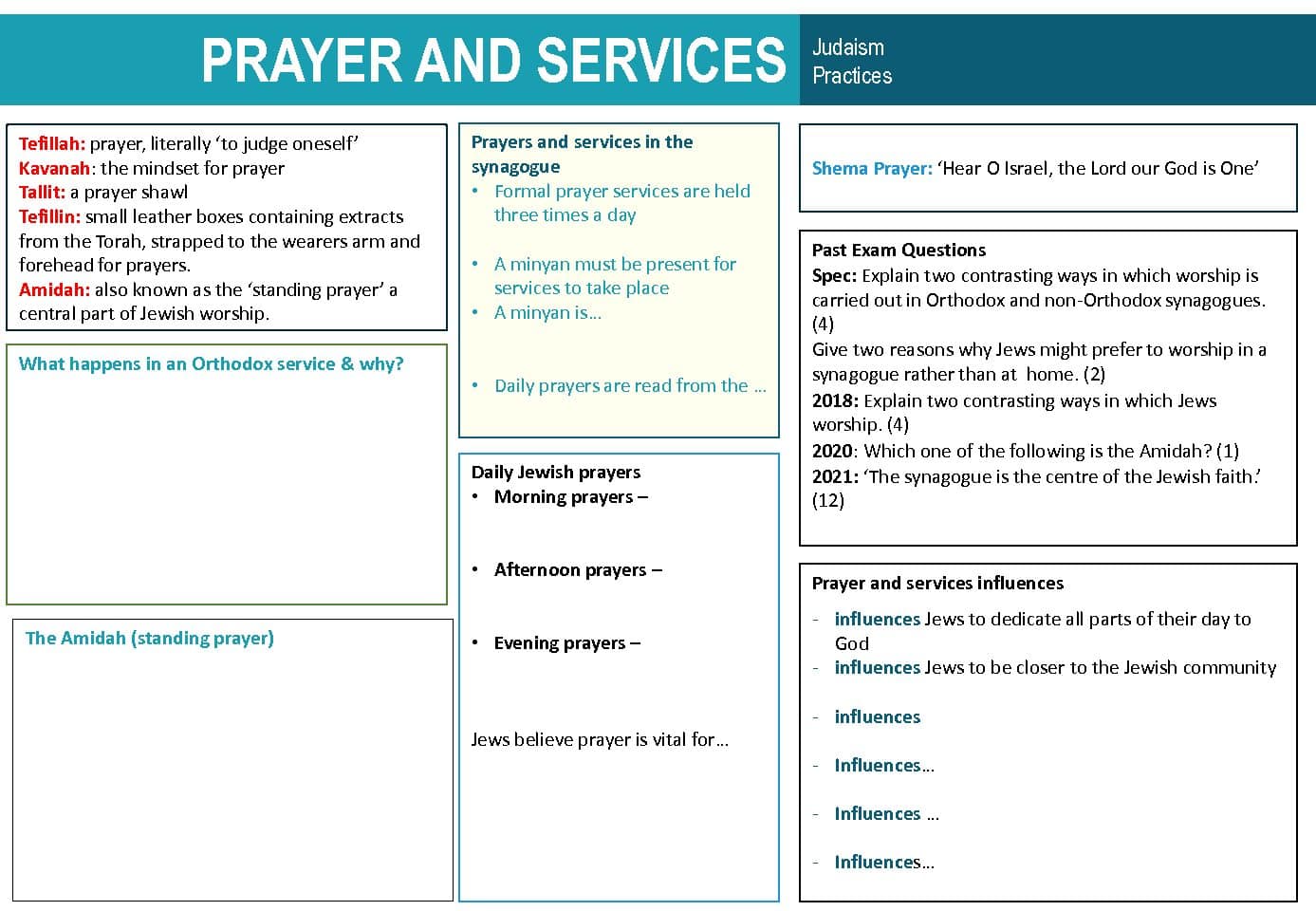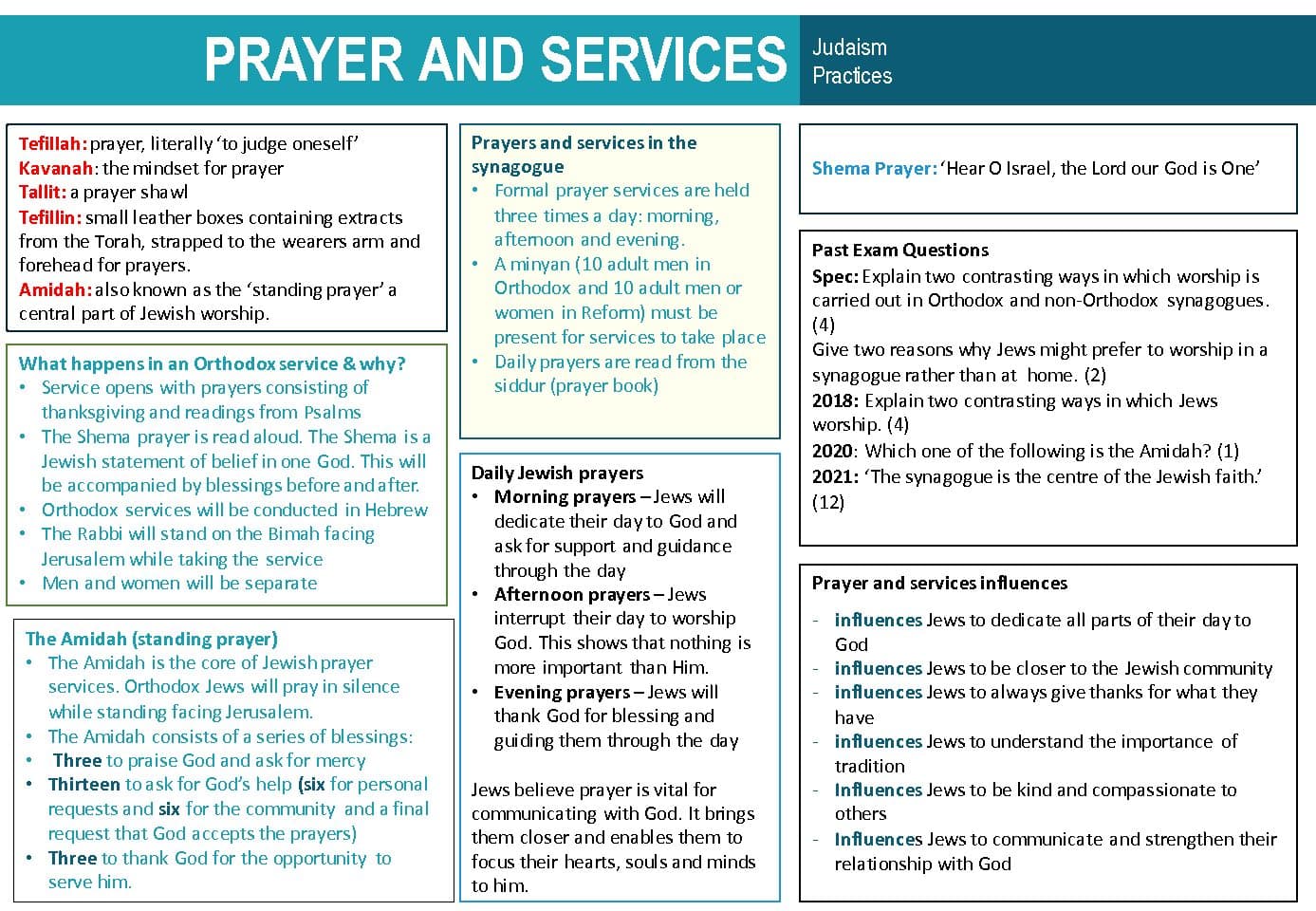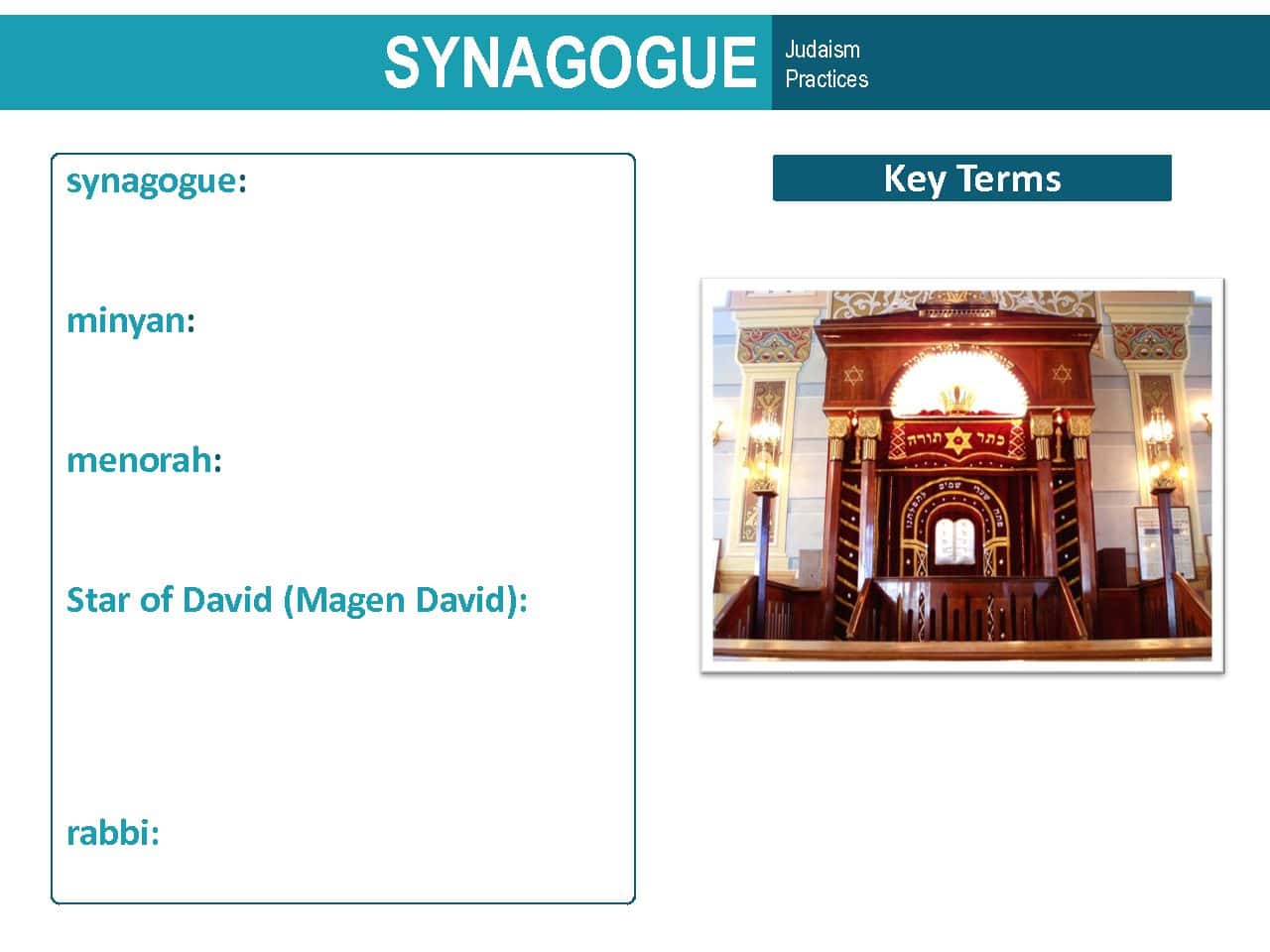Judaism Practices
The Synagogue, prayer and services
The synagogue and worship
- The synagogue and its importance
- The design and religious features of synagogues including bimah (reading platform), aron hakodesh (ark), ner tamid (ever burning light) and associated practices; differences between Orthodox and Reform synagogues
Public acts of worship including:
- synagogue services in both Orthodox and Reform synagogues
- the significance of prayer, including the Amidah, the standing prayer
Synagogue
Explain two contrasting religious features of a synagogue. (4)
2020
- Ner Tamid / eternal light / represents God’s presence / Shekhinah / kept lit at all times / shows God is with his people through good and bad / Exodus 27:20 and Leviticus 24:2 – God commands people of Israel to keep the light burning in the Tabernacle at all times / Ner Tamid is this light.
- Aron Hakodesh / ark of the covenant / represents tabernacle / contains the Torah / sacred space / at front of synagogue toward which all worshippers face / adorned with much Jewish symbolism reminding of beliefs / Eastern wall in UK synagogues – Jews must face Jerusalem when praying.
- Bimah – raised platform from which the Torah is read / raised to show separation between ordinary and holy spaces / central within synagogue, as was Holy of Holies in temple in Jerusalem / in Orthodox synagogue, male worshippers seating faces toward bimah / in many synagogues, not a raised space, so worshippers stand when it is read from.
- Ten Commandments – reminder of covenant with Moses / reminder of need to keep God’s laws.
- Menorah – seven-branched candlestick / represents seven days of creation / reminder of God’s creative power.
- Women’s gallery/space – in Orthodox, separating men from women for worship, etc.
Explain two contrasting ways in which worship is carried out in Orthodox and reform synagogues. (4)
Spec 1
Orthodox
Men and women sit separately; young boys under 13 sit with the women; everything is in Hebrew; the person leading the service has his back to the congregation and prays facing the same direction as the rest of the congregation; worship may be fairly ‘free form’ with individuals turning up and joining in at different times and not necessarily doing things in the same way – they may have different customs about where to stand and where to pray for example.
Reform
Men and women sit together; most of the service may be in English; the person leading the worship faces the congregation most of the time; the congregation worships together, doing the same thing at the same time. They may use an organ, sometimes a choir in worship.
Explain two contrasting ways a synagogue might be used by Jews. (4)
2022
- Worship / communal or individual / services are held regularly for worship (beit tefilah – house of prayer).
- Shabbat observance / families attend on Friday evening / Saturday morning.
- Prayer / provides sufficient Jews to allow certain prayers to be said – minyan 10+ adults / differences between Orthodox and Reform / Amidah (standing prayer).
- Houses important religious items / eg Torah scrolls, Ner Tamid (Eternal Light).
- Festivals celebrated within the community / eg Yom Kippur, Pesach (Passover).
- Rites of passage ceremonies / eg Bar Mitzvah / Bat Mitzvah.
- Life cycle ceremonies / for instance marriages / conversion ceremonies / baby blessings
- Education / Jews of all ages can use the synagogue for education / teach young Jews Hebrew / so they have a better understanding of prayers / there is often a library to help older Jews to continue their studies (beit midrash – house of study) / Shabbat morning Torah study before the service (Shiur).
- Social activities / provides social hall for the use of people of all ages / youth clubs / music and drama groups / groups of senior citizens / charitable fund-raising events / social activism discussions (beit kehilla – house of community), etc
Explain two ways in which the ark (Aron hakodesh) is important in the synagogue. (5)
Spec 1
- the Ark is a cupboard where the Torah Scrolls , which contain the text of the Hebrew Bible, are kept. It is named after the wooden chest which held the stone tablets of the Covenant that God gave to Moses on Mount Sinai. Reference to Jewish teaching about the Torah
- the presence of the Ark, and of the scrolls within it, make the synagogue a holy place. According to Jewish teaching, honour must be shown to it, no one should sit with their back to it. In Great Britain it is put against the eastern wall of the synagogue so that worshippers facing the ark are also facing Jerusalem
- the Ark plays a key part in worship. At the right moment in a synagogue service the Ark is ceremonially opened, and the Torah scroll is carried in procession to the reading desk, unrolled to the reading chosen for the day and laid on the reading desk, after the reading is over, the scrolls are returned to the Ark. Teaching about the importance of such readings.
The synagogue is the centre of the Jewish faith.’ (12)
2021
Arguments in support
- The synagogue is a place for Jews to worship, meet others in their faith community and to study.
- The synagogue contains the ark where the scrolls of the Torah are kept / ‘He brought the ark inside the tabernacle. Then he put up the curtain for screening, and screened off the Ark of the Pact – just as the Lord had commanded Moses.’ (Exodus 40:21) / these scrolls assist in the learning of the faith.
- Some prayers can only be said in the presence of a minyan (10 adults / men) which is easier to have in a synagogue / other prayers are thought to be better prayed together in a group of Jews / synagogue is often referred to as a ‘House of Prayer’ (Beit T’filah).
- Shabbat services take place weekly in a synagogue / ‘Remember the sabbath day and keep it holy’ (Exodus 20:8) / daily services are provided if there is a minyan to allow them to happen / the amidah prayer forms the core of all Jewish prayer services.
- Synagogues provide a strong focus on the Jewish faith / are ‘decorated’ incorporating Jewish themes, symbols and passages from scripture to provide inspiration.
- Study related to the Jewish faith takes place in the synagogue / Jewish texts are freely available in a synagogue / there is a rabbi together with many other learned Jews to provide assistance in learning / classes are run for children and adults who want to further their knowledge and understanding of the faith or to learn Hebrew / helps Jews to learn about and prepare for ‘faith rituals’ such as Brit Milah, Bar Mitzvah, Bat Mitzvah, marriage.
- Synagogues provide social spaces for Jews to meet other members of their faith in a ‘social hall’ / many provide facilities for social interaction between young Jewish people / charitable works, required in the Jewish faith, are centred on the synagogue / money may be collected in the synagogue and distributed to the needy either in the local community (including the local Jewish community) or to other national or international causes / the needs of the elderly are provided for, etc.
Arguments in support of other views
- The home is the centre of the faith because it is the place of the family unit, considered very important in preserving the faith and passing it to the future generations / it is where children are raised in the faith / Brit Milah usually takes place in the home as a new baby is welcomed to the faith / the home is a place of love, nurture and safety for all who live there.
- The home has a large part in Shabbat observance which is central to the faith / the family is involved in Shabbat at home / preparations for Shabbat are made at home and the Friday meal is eaten at home / the ceremonial aspects of it / the rest of Shabbat may be spent with the family studying the Torah or just having quality family time (although many will visit the synagogue on the Saturday morning) / the havdalah service is performed to end Shabbat at home.
- Daily prayers can be said at home / homes have reminders of the faith such as mezuzahs, symbolism and copies of Jewish texts.
• The laws of kashrut (dietary laws) are based on the home and are observed there. - The remains of the Temple in Jerusalem, especially the Western Wall, are a reminder of a time when the Temple was considered to be the centre of the faith / if it were to be rebuilt, it may regain this ‘status’ / many may see Jerusalem or Israel as the centre of the Jewish faith.
- As God created the earth and everything it contains, everywhere should be respected and praise and thanks should be given to God for providing it, etc.
Prayer & services
Give two reasons why Jews might prefer to worship in a synagogue rather than at home. (2)
Spec 2
The word synagogue means ‘coming together’ or ‘house of assembly’ in Hebrew/synagogues replaced the place of worship for Jews after the destruction of the Temple in Jerusalem after 70 CE/certain prayers can only be said by a communal group of ten or more men (minyan) in Judaism/reading the Torah in Hebrew is an honour and public recognition of skill in Judaism/all of these important features of worship can be observed in the synagogue/worship in a synagogue is more formal and ritualistic/worshiping as a community preserves the Jewish identity/it also affirms a sense of belonging etc.
Explain two contrasting ways in which Jews worship. (4)
2018
- Jews may worship in the synagogue or at home / examples may include practices from different Jewish denominations / may include liturgical and non liturgical prayer
- Worship at home may be more spontaneous, whereas at the synagogue it follows a set pattern
- Worship at home involves the family whereas at the synagogue the Jewish community is involved
- Worship in the home on Shabbat involves food and drink whereas worship at the synagogue is more focused on the Torah and prayer
- Worship in the home is led by the mother and father of the household whereas at the synagogue it is led by the cantor and rabbi
- At the home worship may be in English whereas at the synagogue it is more likely to be in Hebrew
- Worship at home involves the whole family praying together whereas in Orthodox synagogues men and women sit separately, etc.
- Alternative forms of worship are credit worthy – for instance showing devotion to God through actions eg. Keeping kosher, charitable acts, touching the mezuzah, saying the Shema privately etc
N.B. If similar beliefs are given, only one of them may be credited up to 2 marks maximum.
Resources
Videos








